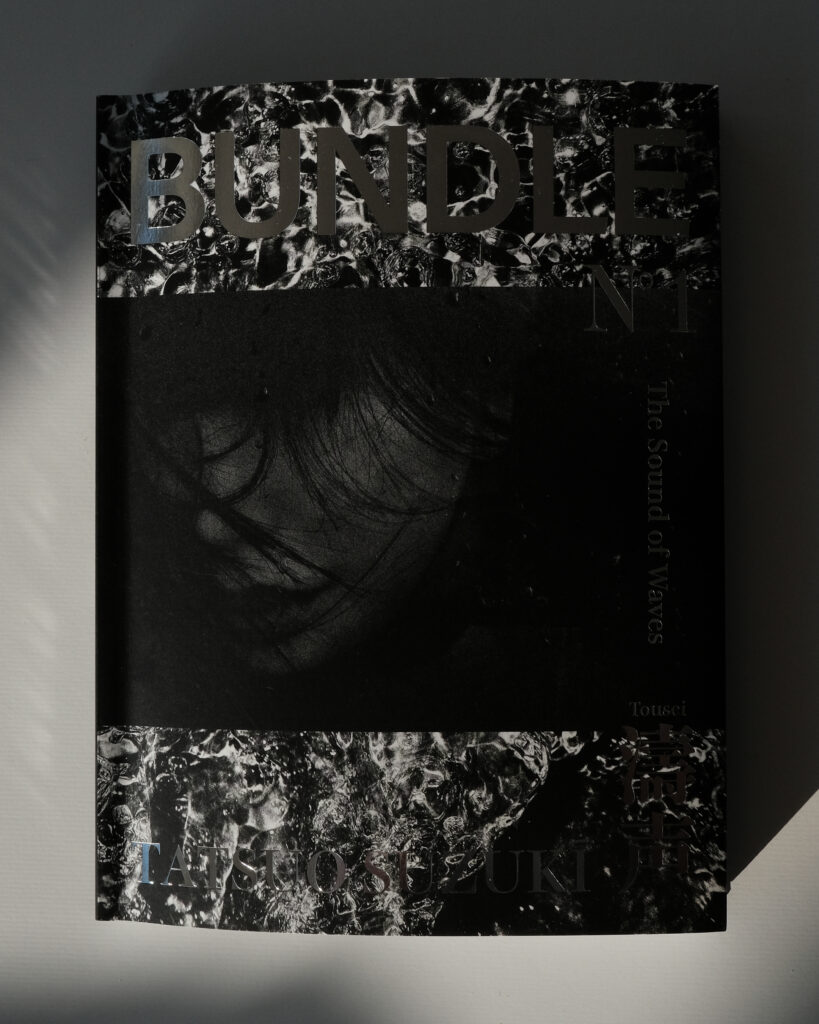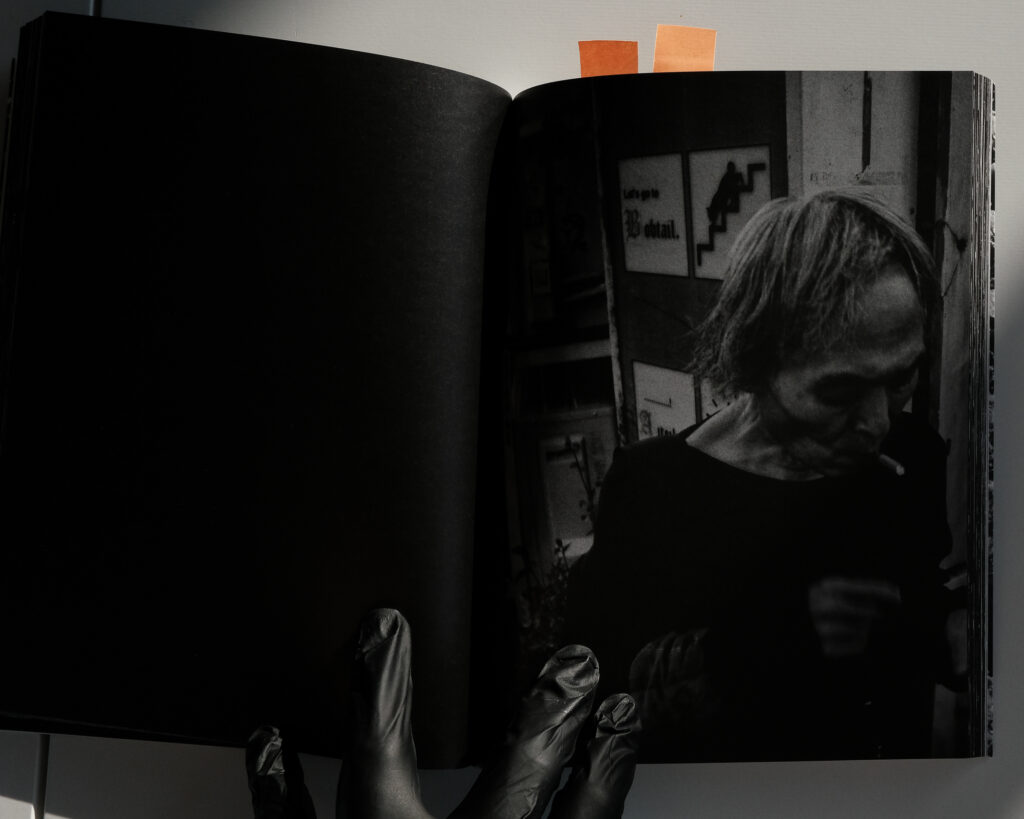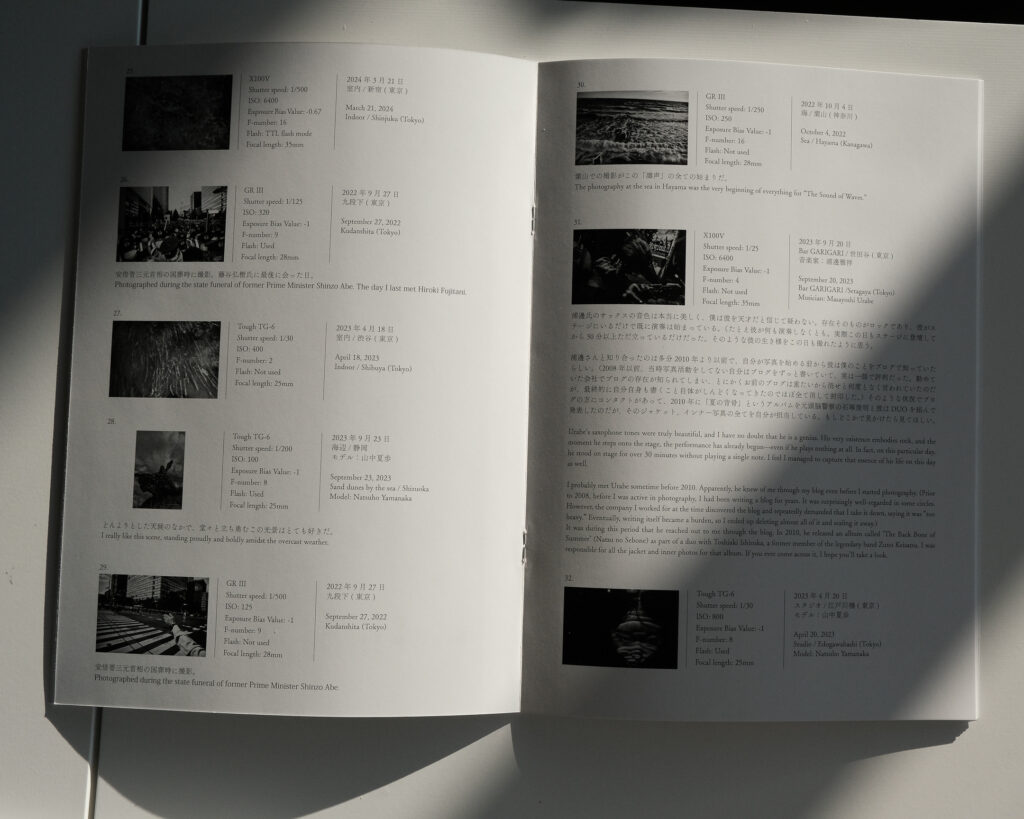
Book Characteristics
Book: Bundle N°1 The Sound of Waves (Tousei)
Author: Tatsuo Suzuki
Publication date: 2025
Publisher: Self-published
ISBN: None
Book type: Softcover
Book size: 18 X 24 cm
Number of copies: Unknown
Number of pages: 160
About the author
Tatsuo Suzuki is a late starter but a fast learner. At the age of 43 he started taking photos, while being employed as an office worker. Six years later, in 2014, he became a full time photographer. In 2016, he was awarded the Grand Prize by Steidl Book Award Japan. His first book, Friction / Tokyo Street, was published in 2020.
Recommended music
The claustrophobic and chaotic aspect of this book makes me think of the 3 title release “Inagape” by Trhä (if I start writing about music, an article about Damian Anton Ojeda the genius behind Trhä, Sadness and many other projects will be needed).
As someone that had missed on buying Tatsuo Suzuki’s “Friction: Tokyo Street” which now sells for a price I am not ready to spend on it, I was extremely excited when I saw that Suzuki announced a new printed project. To kick this off, Tatsuo Suzuki set up a crowdfunding in which I participated in order to secure the first iteration of his new BUNDLE serie: The Sound of Waves (Tousei in japanese).
The crowdfunding campaign was a success, but does the book live up to the public’s expectations?

The first clarification that is needed is that while “Friction: Tokyo Street” was a purely streetphotographic exercise, Tousei explores many other faces of the photographic medium, by incorporating portraits, concert photographs, and some abstract-leaning works. The fans of Tatsuo Suzuki’s streetphotography might therefore be disappointed: although the book incorporates some streetshots, they are, in my humble opinion, less striking than some of the fulgurant work featured in the author’s first book.
Does that mean the book is bad?
Not in my opinion. This project somehow felt like a more personal project as we could see different aspects of Tatsuo’s photography, such as his energy-filled shots of the band AKOGARE, or his portraits, always shot with a distinctive style. This impression of facing a very personal work was confirmed when I read the foreword written by Chihiro Kobayashi in which it is mentioned that Tatsuo started shooting water very intensively after the death of Hiroki Fujitani, a close friend of his and member of Void Tokyo, as he once imagined his lost friend greeting him with the sound of a wave.

Although the project contains many different types of works, it has a coherence through the energy that emanates from the images. While water might be praised for its calm aspect,it is its opposite face that is shown in Suzuki’s book. While water is depicted as an element that carries a profound but chaotic energy, it is aslo used as a symbol of Suzuki’s mourning and his quest to listen to his lost friend through the sound of waves.
In addition to this visual chaos, another property shared by almost all of the images are their close proximity with their subject. Water is captured from upclose as if Tatsuo crossed through it. The musicians are shot closely too, and so are the models in the portraits.
This close proximity creates a surprisingly pleasant sensation of claustrophobia, participating in the intensity of this book, but also being responsible for a feeling of relief whenever an image showing a wider scene is disclosed. As an example of this chaos/relief rythm, we can think of a street photograph showing the arm of a police officer pointing in a direction, or of an other image showing a quiet street at night. Both are an escape from the chaotic upclose images. One of those relieving images that is particularly striking is the one displaying a calm landscape of the sea with some pine trees in the foreground. In itself, this image is not that strong. In the context of the book, it is an absolutely needed catharsis. It creates a moment of calm but also helps you realise the chaos in which the book plunged you, had you not processed it until then.
Images showing a wider scene help to get out of the frenzy the book plunges us into.
For this reason, the sequencing is perfectly done, we jump flawlessly from close-up portraits to close-ups of water. The sensation of chaos and claustrophobia emanating from this book, similar to what one can feel when mourning, does not only come from the images themselves but also from the way they are organised in the book. Throughout the book, we can understand that this book is about mourning. This particularly struck me when I saw some images where water looks like a night sky filled with stars followed by an image with a face of a model appearing through the waves. The closing image, full of vitality, of a kid playing next to the water is a welcome conclusion to the mourning illustrated throughout the book.
A particularly strong sequence of images in which water mimicks a night sky.
The portraits, often containing water, are also carrying this convulsive energy. The models, exclusively women (why?), are captured in a way that does not look staged, as if Suzuki managed to press the shutter at the exact moment the model forgot they were there to pose for images (or perhaps creating this effect is part of the toolkit of a talented model). All the portraits share a very nostalgic aspect which is enhanced by Suzuki’s grainy and raw use of black and white. A particularly strong image is the one of a single eye with a tear. Some other portraits are very strong, such as the ones including water, or the surrealist one done in a place where the air was filled with a static charge due to a thundercloud.
Some of my favourites portraits from this amazing book.
You might now wonder how I knew that a static charge was the reason for the model, Natsuho Yamaka, to have her hairs standing up? And how do I even know the model’s name?
Well, this is due to a great idea Suzuki had. Anyone buying the book on Kickstarter received it with a booklet alongside containing the technical aspects of each images (camera used, shutter speed, ISO, Aperture, use of flash and focal length). In addition to that, the date, location and model is disclosed as well. This is a great complement to the book as it helps understand the techniques that participates in the unique style we find in Suzuki’s work. For some of the images, a few sentences explain some anecdotes about how the images were made or about the location they were made in. This is a great complement to the book and something I would love to see more often, although one might argue that a magician shouldn’t reveal its tricks…

In the artwork documentation booklet you will find all the images, their technical settings and a few sentences about some of the images.
Something that I definitely do not want to see more often and that constitute a weak point of this project is related to the design of the book.
On a first sight, the book looks great with its chrome embossment that matches the dynamism of Suzuki’s images. The problem I have, and sadly it is a recurring issue, is that the book is not a “layflat” type of book. As often with books that closes themselves when you are not actively maintaining them open, the images that spread on two pages were hard to appreciate for me as the middle of the image is ruined by the book design. For some images, it even makes it impossible to know if we are looking at two images in portrait format or at a single landscape one. Furthermore, it creates a bit of annoyment when you have to press on the book to see as much of the image as you can. As I said it, this is something I see in a lot of books and it would be good if more layflat books were released. This is not against Tatsuo Suzuki, but rather against a good portion of the photobooks producers. Why is it still acceptable in 2025 to release book that require active physical efforts for the images to be seen under their best light? When I go through a book, I want it to be a smooth experience.
Despite this negative note, I would highly recommend buying this book as it is a good demonstration of how one can “escape” streetphotography which sometimes has an athletic aspect to it (more about this in a blog post soon, subscribe to the newsletter), by proposing a photography that is more personal and that therefore has a stronger artistic resonance. After going through that book, I can only be impatient to see what is next. I have not mentioned it until now, but “Tousei” is only the first publication of the BUNDLE series, and I believe it is a perfect start.

2 Responses
Nice review, thanks for that!
Thanks, glad you enjoyed it!